In the New York City Ballet’s grand tradition of ambitious festivals of new work, its current offering, Architecture of Dance, is a big, ambitious deal: seven new ballets; four of them to commissioned scores; five sporting sets by the famed architect Santiago Calatrava. Three of the works are by the men who are arguably the most exciting ballet-makers in the world right now: Alexei Ratmansky, Wayne McGregor and Christopher Wheeldon. In New York, the Royal Ballet's resident choreographer McGregor is the least-known of that trio - this is his first commission for an American company, and Friday night’s premiere of his Outlier was probably the first sighting of his specific aesthetic by many in the audience.
That aesthetic - the jagged, highly coordinated, fragmented movement, the body-baring utilitarian costumes, the matter-of-fact abstraction - seems perfectly suited to City Ballet’s Balanchine heritage of quick-moving, athletic, unsentimental dancing. Perhaps too perfectly suited, since it has been the interplay between the sharp modernity of the movement and the emotional intensity that the Royal Ballet dancers have brought to McGregor’s choreography that has given his works for that company their particular resonance. (This was clear watching his 2007 Genus for the Paris Opera Ballet. Brilliantly conceived and performed, but without much emotional undertow, it felt both more dazzling and more superficial than the Royal Ballet pieces.)
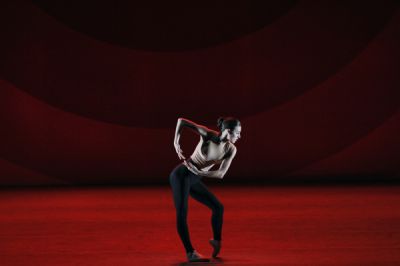 Emotional intensity isn’t exactly a City Ballet characteristic, but there was no need to worry. Outlier, set to Thomas Adès’s violin concerto Concentric Paths, is another successful foray into the strange landscape of McGregorworld, all angular peaks and organic curves, flashing superhuman limbs and vulnerable buckling undulations. It begins with a woman (Tiler Peck) standing alone in the middle of a red-ringed circle on a darkened stage (pictured right). A man (Craig Hall) walks around her as low, slightly ominous sounds (a snatch of prerecorded music from the film Solaris) begin. Then he takes her hand and moves in close with swerving upper-body arcs that seem to propel her into motion; the effect is of a force-field between them, as if the air that he displaces moves her in turn.
Emotional intensity isn’t exactly a City Ballet characteristic, but there was no need to worry. Outlier, set to Thomas Adès’s violin concerto Concentric Paths, is another successful foray into the strange landscape of McGregorworld, all angular peaks and organic curves, flashing superhuman limbs and vulnerable buckling undulations. It begins with a woman (Tiler Peck) standing alone in the middle of a red-ringed circle on a darkened stage (pictured right). A man (Craig Hall) walks around her as low, slightly ominous sounds (a snatch of prerecorded music from the film Solaris) begin. Then he takes her hand and moves in close with swerving upper-body arcs that seem to propel her into motion; the effect is of a force-field between them, as if the air that he displaces moves her in turn.
There are all kinds of delicate physical detail in these opening moments of Outlier - the way Hall moves Peck’s hands up her back, the quick neck rolls and shoulder articulations, the repetition of some of the arm sequences even as she is held upside down in an arrow-straight line. (There’s a momentary evocation of the cross image as she opens out her arms in this position.)
As the violin concerto starts, a scrim goes up revealing a backdrop of lipstick-red circles that is perhaps a reference to the score’s title. It’s a striking backdrop to the five dancers who have appeared on stage, and who begin a series of quick encounters: a sensory overload display of wheeling legs and extreme extensions, wrenched from their classical lines. At first, the activity seems frenetic, but you soon start to notice tiny beauties - a leg brought down very slowly from a high second position, the way McGregor juxtaposes different scales of motion, the sculptural effects he achieves by incrementally drawing the pairs closer to one another at the end of the movement.
Listen below to an extract from Thomas Adès's violin concerto 'Concentric Paths' YouTube
The third section (the second movement of the Adès concerto) is the heart of the ballet, framed by two pas de deux. The first is for Maria Kowroski and Robert Fairchild, who move to initially hesitant violin strains, punctuated by fierce percussive blasts. Their dance is both combative (it opens with Kowroski pushing Fairchild away) and nervily sinuous, and it contains numerous echoes of the second act pas de deux from William Forsythe’s Artifact in its use of classical positions re-imagined on different planes - lying on the floor, bent over at odd angles, pulled along on pointe. (Forsythe’s influence on McGregor’s choreography is clear, but he has absorbed and assimilated these ideas without needing to resort to imitation. The Moritz Junge costumes, on the other hand, with their briefs and long-sleeved tops for the men, leotards and tights for the women, are pitch-perfect Forsythe gear.)
The final pas de deux in this section (following a briefer all-male duet for the spectacularly bare-chested Amar Ramasar and Fairchild) is for Wendy Whelan and Craig Hall (pictured below left), and it’s a glorious thing. Whelan is City Ballet’s greatest ballerina, and it’s because her dancing is always of the moment, an expression of the world right now. In Outlier she gets choreography that is in fact more lyrical, more recognizably balletic in its lexicon, than most of the other dancers. 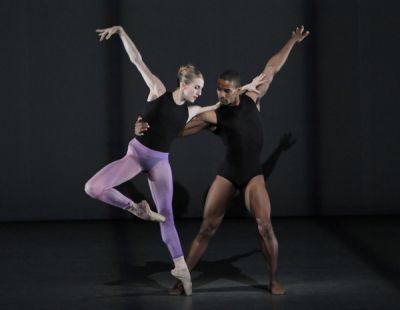 The Whelan-Hall pas de deux, set to a slow, slightly foreboding melody and back-lit by a glowing yellow panel, is a traditional sort of centerpiece, or culmination - the white act pas de deux of Swan Lake, the wedding pas de deux of Sleeping Beauty. Hall mostly supports Whelan in a gorgeous series of plunging arabesques and fluid, slippery lifts, but both bring a seriousness of intention to each moment that makes the duet something greater than the sum of its parts. At the end, he whirls her off stage across his back, as the violin plays a plaintive, circular refrain.
The Whelan-Hall pas de deux, set to a slow, slightly foreboding melody and back-lit by a glowing yellow panel, is a traditional sort of centerpiece, or culmination - the white act pas de deux of Swan Lake, the wedding pas de deux of Sleeping Beauty. Hall mostly supports Whelan in a gorgeous series of plunging arabesques and fluid, slippery lifts, but both bring a seriousness of intention to each moment that makes the duet something greater than the sum of its parts. At the end, he whirls her off stage across his back, as the violin plays a plaintive, circular refrain.
That whirling departure prefigures the ballet’s final image, and echoes the images of circularity and curvature that McGregor uses with particular emphasis in the final section. Here, he picks up on the rhythmically bright, spiky final musical movement called “Rounds”, in which the soloist (the marvelous Kurt Nikkanen) keeps joining, then departing from, the ensemble’s syncopated refrain.
McGregor doesn’t echo this structure choreographically; he uses nine dancers (his use of odd numbers – the full cast is 11 – is intriguing) in a masterly structural display of choreographic quick-change. On an initially brightly lighted stage, lines of dancers move forward with military briskness, then dissolve into quick pas de deux for different pairs (the marvelous Sterling Hyltin gets her moment here, pictured below right), groups forming and dissolving behind. Midway through, the lights (by regular McGregor collaborator Lucy Carter) darken and catch the dancers in grid-like blocks of colour. Then in an echo of the opening section, a pair dance in the centre of a circle of light, a woman walks around its perimeter, and suddenly they coalesce into trios, moving with the same steps but on different trajectories.
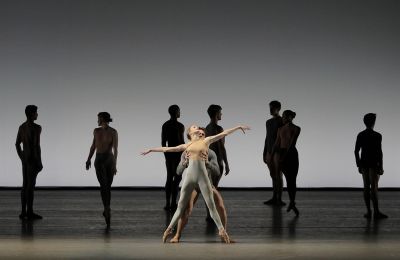 Just as suddenly, the configuration changes, and they become pairs, the women whirled around as a line of men walks away. It’s the end, and a brilliant one, leaving you disoriented in just the right way, feeling that the ballet’s life is continuing somewhere beyond the darkness and the dropped curtain.
Just as suddenly, the configuration changes, and they become pairs, the women whirled around as a line of men walks away. It’s the end, and a brilliant one, leaving you disoriented in just the right way, feeling that the ballet’s life is continuing somewhere beyond the darkness and the dropped curtain.
This last section of Outlier is perhaps better than the preceding ones; there are parts of the ballet in which the fractured angles, juddering torsos, funny little bobbing heads and quick juxtapositions of position can look overdone and willful. Then again, this may seem less apparent as the City Ballet dancers settle into the ballet; this is not yet their stylistic universe and they can look as if they are performing the movements without knowing why, rather than showing them as an inevitable consequence of the preceding moment.
But Outlier is completely absorbing in its relentless physical inventiveness and its fluid, unpredictable changes of speed and texture; at every moment you wait on the edge of your seat to see what the dancers will do next, what they might be capable of. It’s this sense of possibility that makes the ballet - and ballet - so thrilling. Despite the criticisms that will inevitably come about the dehumanized nature of the movement, its non-sequitur use of the classical vocabulary, and the like, McGregor makes something completely contemporary and deeply human of his dancers. Their activities might be mysterious (and aren’t our own activities mysterious, even to ourselves?), but they feel like part of the world we live in now.
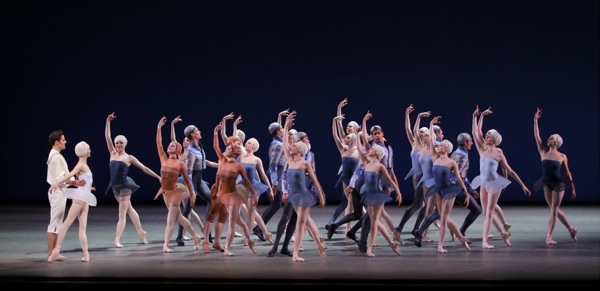
If Outlier looks towards ballet’s future, the first festival premiere, Alexei Ratmansky’s Namouna (pictured above), is a deliberate turn to the past. And yet, its references are so deliberate, so quixotic and so brilliantly executed that its final effect is of contemporaneity. Could anyone else but Ratmansky could have taken the deliciously melodic score by Lalo, first used for a ballet by Lucien Petipa (the great Marius’s older brother) at the Paris Opera in 1882, and convincingly presented a battalion of Louise Brooks lookalikes, lovelorn mermaids, a chain-smoking ballerina, a hapless sailor-suited hero and a gang of pirates headed by Puck and two fairies?
The ballet, which is subtitled “A Grand Divertissement” is a four-act ballet squashed into an hour, the niceties of plot removed (a kind of wink at the absurdities of 19th-century ballet stories like Le Corsaire and La Bayadère), just the grand divertissements remaining. One bewildering scene succeeds another, starting with the Louise Brooks corps de ballet entering in a long, winding line like the Shades from La Bayadère, and threaded together loosely by the sailor-suited hero’s quest for Namouna. She turns out to be Wendy Whelan, one of a ballerina triumvirate (with Sara Mearns and Jenifer Ringer) who keep reappearing in different guises throughout the ballet.
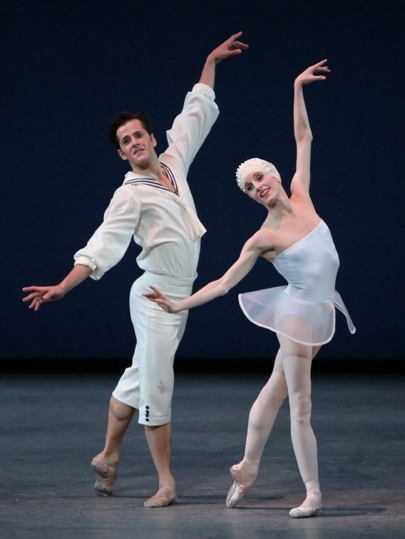 At the end they are disguised among a corps clad in identical short blue petal-like and white Marcelled wigs. Like the Prince in Swan Lake, Fairchild first searches disconsolately, then finds his princess. There seems to be a wedding; the Pirates approve, the lovers kiss. It’s not over too soon – the piece is an hour long, and it seems to end about five times - but it leaves you charmed and wildly entertained. (And, first time around, wildly puzzled.)
At the end they are disguised among a corps clad in identical short blue petal-like and white Marcelled wigs. Like the Prince in Swan Lake, Fairchild first searches disconsolately, then finds his princess. There seems to be a wedding; the Pirates approve, the lovers kiss. It’s not over too soon – the piece is an hour long, and it seems to end about five times - but it leaves you charmed and wildly entertained. (And, first time around, wildly puzzled.)
Namouna offers a lavish display of sensational dancing and a fine demonstration of Ratmansky’s ability to capture the essence of particular dancers. The bravura solo for Mearns perfectly demonstrates the voluptuous, wild quality of her dancing; the cigarette dance for Ringer plays up her comic timing; the final pas de deux for Whelan and Fairchild (picture left) displays the ballerina’s steely delicacy and Fairchild’s somehow innocent expansiveness; Daniel Ulbricht gets every petit batterie jump in the textbook in his role as pirate leader (or Puck, who knows?), and pulls it off with ridiculous aplomb.
Namouna pays affectionate homage to ballets past (the references flash by regularly, but you would get the general idea even if you didn’t know them), but in the end it feels present-tense too, a kind of meditation on the role of the 19th-century ballet and how we use or understand its heritage. As a friend said, you can take it quite seriously and dismiss it simultaneously. At the very least, it’s a great deal of fun.
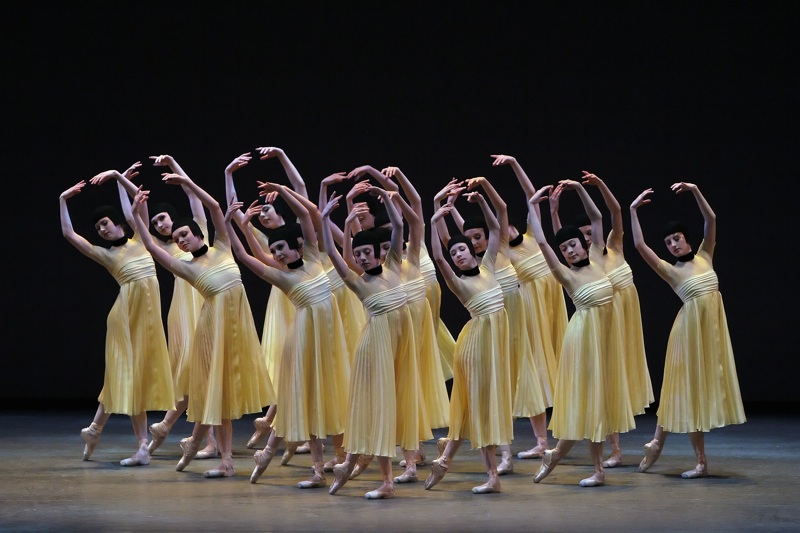

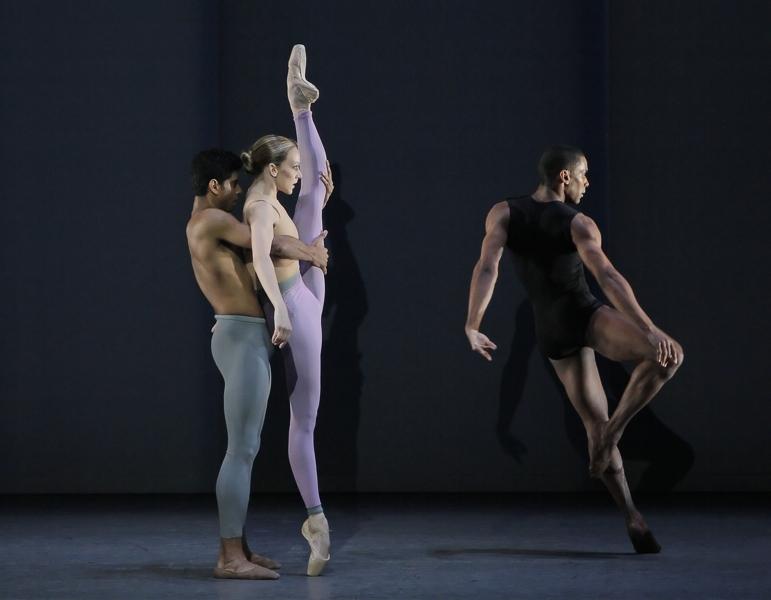












Add comment